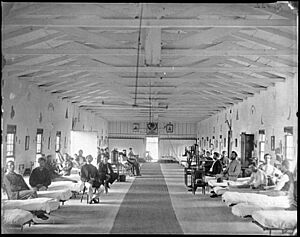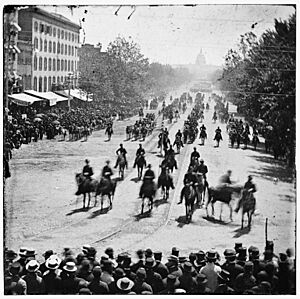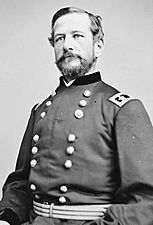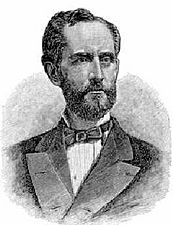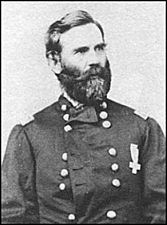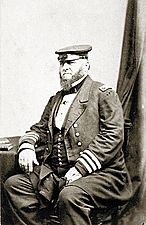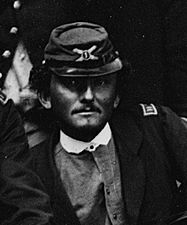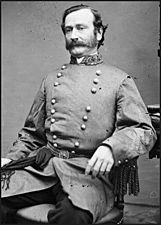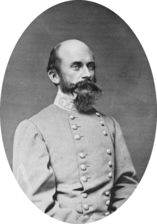Washington, D.C., in the American Civil War facts for kids
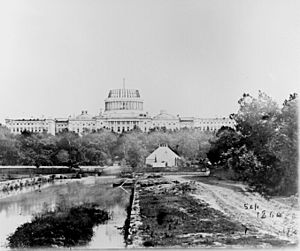
During the American Civil War (1861–1865), Washington, D.C. was the capital city of the United States. It became the main center for the Union side during the war. The city quickly grew from a small town into a big capital. It gained new buildings, services, and strong defenses.
After the Union lost the First Battle of Bull Run in July 1861, many soldiers were sad and confused. President Abraham Lincoln then ordered many new forts and a large group of soldiers to protect the city. This brought many troops, suppliers, and builders to Washington. They needed places to live, including military hospitals. In 1862, slavery ended in Washington. This brought many freed people to the city. The capital stayed safe, except for one attempt by Confederate cavalry leader Jubal Early in 1864.
When President Lincoln was shot in April 1865, thousands came to Washington. They wanted to see his coffin. This made the city even more famous. The new president, Andrew Johnson, wanted to cheer people up. He planned many victory parades. These parades helped people feel hopeful about the future.
Contents
Washington D.C. at the Start of the War
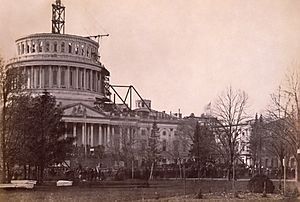
Even though it was the nation's capital city, Washington was a small city. It was almost empty in the hot summer months. But this changed when the Civil War began. In February 1861, a group called the Peace Congress met in the city. They tried to stop the war from happening. But their efforts failed, and the war started in April 1861.
At first, it seemed like nearby Virginia would stay with the Union. But then Virginia voted to leave. This created a big danger. The state of Maryland was divided. If it also left the Union, Washington would be surrounded by enemy states. President Abraham Lincoln had to act fast. He had some pro-slavery leaders in Maryland jailed. This helped save the capital from being surrounded.
Lincoln then started to gather soldiers to protect Washington. The Confederates wanted to take Washington. They gathered their forces to attack. By April 10, Union soldiers started to arrive in the city. On April 19, the Baltimore riot made it hard for more soldiers to arrive. Andrew Carnegie helped build a new railroad around Baltimore. This allowed soldiers to reach Washington by April 25. This saved the capital.
Thousands of new volunteers and trained soldiers came to fight for the Union. By mid-summer, Washington was full of volunteer regiments and artillery groups. The city itself was still small. In 1860, it only had about 75,800 people.
Washington became the starting point for the Manassas campaign. After the Confederates won the First Battle of Bull Run, Brigadier General Irvin McDowell's tired army came back to Washington. People then realized the war would last a long time. So, they began to build forts around the city. These forts would protect it from a Confederate attack. Lincoln knew he needed a strong, trained army. He created the Department on the Potomac in August 1861. Sixteen days later, he formed the Army of the Potomac.
Most people in Washington welcomed the soldiers. Some people were not interested, and some even supported the Confederates. One resident, Julia Ward Howe, heard Union soldiers singing "John Brown's Body." She then wrote the famous patriotic song "Battle Hymn of the Republic" to the same tune.
The federal government grew a lot to manage the war. This also led to more people moving to the city. The population grew a lot in 1862 and 1863. More soldiers and support workers came. In 1860, the city had about 75,000 people. By 1870, it had almost 132,000 people. New warehouses, supply centers, and factories were built. They provided material for the Union armies. Many civilian workers and contractors also came to the city.
Slavery was ended in Washington on April 16, 1862. This was eight months before Lincoln's Emancipation Proclamation. It happened with the Compensated Emancipation Act. Washington became a popular place for formerly enslaved people. Many of them helped build the ring of forts around the city.
Protecting Washington D.C.
At the start of the war, Washington had only one old fort, Fort Washington. It was about 12 miles (19 km) south of the city. The Union Army soldiers were the city's main defense. When Maj. Gen. George B. McClellan took command in August 1861, he was in charge of protecting the capital. McClellan started planning a full circle of trenches and forts. These would cover 33 miles (53 km) of land. He built forts on high hills around the city. He placed strong artillery guns between these forts. This added to the 88 guns already facing Virginia. Between the gun batteries, soldiers dug connected rifle pits. This allowed them to fire together very well. Once finished, this made Washington one of the most protected places in the world. It was almost impossible to attack.
Most of the time, these defenses stopped the Confederate Army from attacking. One famous attack happened during the Battle of Fort Stevens on July 11–12, 1864. Union soldiers fought off troops led by Confederate Lieutenant General Jubal A. Early. This battle was special because President Lincoln visited the fort. It was the first time since the War of 1812 that a U.S. president was under enemy fire.
By 1865, Washington's defenses were very strong. They covered both land and sea approaches. When the war ended, the defense line was 37 miles (60 km) long. It had at least 68 forts and over 20 miles (32 km) of rifle pits. It also had 32 miles (51 km) of military roads and four picket stations. There were 93 separate artillery batteries. These had over 1,500 guns, including field guns, siege guns, and mortars.
Military Hospitals in Washington D.C.
Hospitals in Washington became very important. They provided medical care for wounded soldiers. Soldiers were brought to the city from the battlefields. They came across the Long Bridge or by steamboat.
Many hospitals were in Washington, D.C., including:
- Armory Square General Hospital
- Carver General Hospital
- Campbell General Hospital
- Columbia General Hospital
- Columbian General Hospital
- Douglas General Hospital
- Emory General Hospital
- Finley General Hospital
- Freedman General Hospital
- Harewood General Hospital
- Judiciary Square General Hospital
- Kalorama General Hospital
- Lincoln General Hospital
- Mount Pleasant General Hospital
- Ricord General Hospital
- Stanton General Hospital
- Stone General Hospital
- Seminary General Hospital
More than 20,000 injured or sick soldiers were treated in these hospitals. Some famous people helped as nurses. These included Clara Barton, who later started the American Red Cross. Dorothea Dix was in charge of female nurses. The writer Louisa May Alcott worked at Union Hospital. The poet Walt Whitman volunteered at hospitals. In 1865, he wrote his famous poem "The Wound-Dresser." Groups like the United States Sanitary Commission also helped a lot. The Freedman's Hospital was built in 1862. It helped the growing number of freed slaves.
Washington D.C. in the Later War Years
As the war continued, the city became very crowded. This put a lot of stress on the water supply. The Army Corps of Engineers built a new aqueduct. It brought 10,000 US gallons (38,000 L) of fresh water to the city every day. Police and fire protection also improved. Work continued on the unfinished dome of the Capitol Building. However, for most of the war, Washington had dirt streets. It also had poor trash collection and bad air in many buildings. This would change after the war under Governor Alexander "Boss" Shepherd.
Important political and military prisoners were often held at the Old Capitol Prison. These included accused spies Rose Greenhow and Belle Boyd. Partisan ranger John S. Mosby was also held there.
Lincoln's Assassination
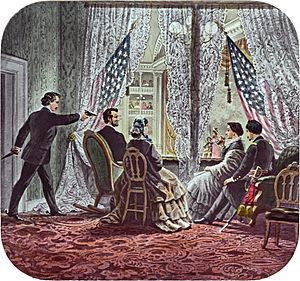
On April 14, 1865, just days after the war ended, Lincoln was shot. This happened at Ford's Theater during the play Our American Cousin. John Wilkes Booth was the assassin. Lincoln died the next morning at 7:22. He was the first American president to be assassinated. Secretary of War Edwin M. Stanton famously said, "Now he belongs to the ages." People in Washington were shocked and angry. Stanton quickly closed most roads and bridges. The city was put under military rule. Many people were questioned or arrested during the investigation.
Lincoln's body was shown in the Capitol rotunda. Thousands of people in Washington and visitors waited for hours. They wanted to see the fallen president. Hotels and restaurants were full. This brought a lot of money to their owners. After the people who helped Booth were found and arrested, their trial happened in Washington. The city was again the center of national news.
Grand Review of the Armies
On May 9, 1865, President Andrew Johnson announced that the rebellion was almost over. He planned a big parade to honor the winning troops. One of his goals was to change the mood in the capital. The city was still sad after Lincoln's death. Three main Union armies were close enough to come to Washington. These were the Army of the Potomac, the Army of the Tennessee, and the Army of Georgia. Officers from these armies met again and caught up. Sometimes, soldiers argued in taverns about which army was better.
The Army of the Potomac paraded first on May 23. Their procession was seven miles long. The mood in Washington was now happy and celebratory. Crowds and soldiers often sang patriotic songs. The parade passed the reviewing stand in front of the White House. President Johnson, General-in-Chief Ulysses S. Grant, and other leaders watched.
The next day, William T. Sherman led 65,000 men. These were from the Army of the Tennessee and the Army of Georgia. They marched through Washington's streets past cheering crowds. Within a week after these celebrations, both armies were broken up. Many volunteer groups were sent home.
Notable Leaders from Washington, D.C.
Several important military leaders were born in the Washington, D.C. area. This includes both Union generals and naval admirals, as well as a leading Confederate commander.
-
Maj. Gen.
Alfred Pleasonton
USA -
Maj. Gen.
Manning Force
USA -
Maj. Gen.
William Montrose Graham, Jr.
USA -
Lt. Gen.
Richard S. Ewell
CSA
Other important people from the Civil War born near Washington included Confederate Senator Thomas Jenkins Semmes. Also, Union general John Milton Brannan, John Rodgers Meigs, and Confederate commander Richard Hanson Weightman.



